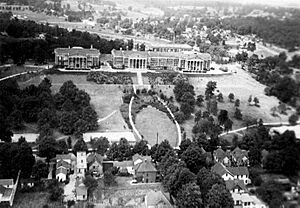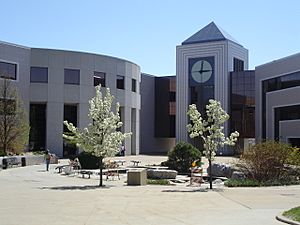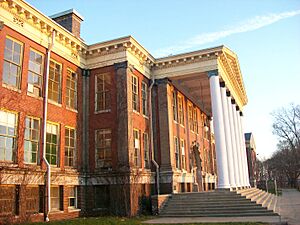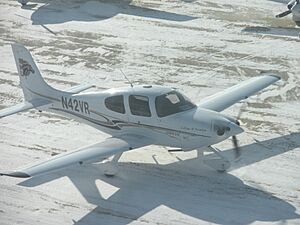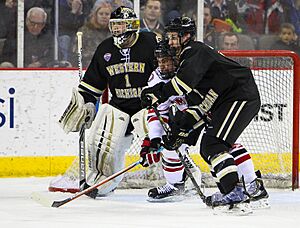Western Michigan University facts for kids
 |
|
|
Former names
|
Western State Normal School (1903–1926), Western State Teachers College (1927–1940), Western Michigan College of Education, Western Michigan College (1955–1957) |
|---|---|
| Motto | So that all may learn. |
| Type | Public research university |
| Established | May 27, 1903 |
|
Academic affiliations
|
Space-grant |
| Endowment | $760.2 million (2024) |
| Budget | $410.6 million (2023/24) |
| President | Edward B. Montgomery |
|
Academic staff
|
751 (full-time) |
| Students | 17,605 (2024) |
| Undergraduates | 13,860 (2024) |
| Postgraduates | 3,745 (2024) |
| Location |
,
,
United States
42°17′00″N 85°36′50″W / 42.28333°N 85.61389°W |
| Campus | Urban |
| Colors | Brown and Gold |
| Nickname | Broncos |
|
Sporting affiliations
|
NCAA Division I – MAC, NCHC |
| Mascot | Buster Bronco |
 |
|
Western Michigan University (often called Western Michigan, Western, or WMU) is a large public university. It is located in Kalamazoo, Michigan, in the United States.
The university first opened in 1903. It was called Western State Normal School back then. Its main purpose was to train teachers. In 1957, its name changed to Western Michigan University.
Western Michigan University is one of eight research universities in Michigan. It offers many different study programs. Students can choose from 147 undergraduate degrees. There are also 73 master's degrees and 30 doctoral programs.
The university's sports teams are called the Western Michigan Broncos. They play in NCAA Division I sports. Most teams compete in the Mid-American Conference.
Contents
History of Western Michigan University
On May 27, 1903, a bill was signed to create a new school. This school would train teachers. Kalamazoo was chosen as the perfect spot for it on August 28, 1903. The first building, now called Heritage Hall, was built in 1904.
The school was first known as Western State Normal School. It offered a two-year program for teachers. Dwight B. Waldo was the first principal, serving from 1904 to 1936. The school's name changed several times over the years. It became Western State Teachers College in 1927. Then it was Western Michigan College of Education in 1941. In 1955, it was called Western Michigan College. Finally, in 1957, it became Western Michigan University.
Many of the oldest buildings are on what is called East Campus. A special train, the Western State Normal Railroad, helped students and staff get up the steep hill to campus. It ran from 1907 until 1949.
Western Michigan University had a partnership with Cooley Law School for many years. This partnership ended in 2020. The university also faced challenges during the COVID-19 pandemic. It had to make changes to save money.
University Presidents
- Dwight B. Waldo (1904–1936)
- Paul V. Sangren (1936–1960)
- James W. Miller (1961–1974)
- John T. Bernhard (1974–1985)
- Diether H. Haenicke (1985–1998)
- Elson S. Floyd (1998–2003)
- Judith I. Bailey (2003–2006)
- John M. Dunn (2007–2017)
- Edward B. Montgomery (2017–2025)
- Russ Kavalhuna (starting 2025)
Exploring WMU Campuses
WMU has over 1,200 acres of land and about 150 buildings. Western Michigan University has five main campuses. Most are in or near Kalamazoo, Michigan. One is in Battle Creek, Michigan.
West Campus: The Main Hub
West Campus is the biggest and main campus in Kalamazoo. Most of the university's main buildings are here. This includes colleges for arts, business, education, and fine arts. The Lee Honors College and Waldo Library are also on West Campus. Many student dorms are found here. Other dorms, called "The Valleys," are right next to West Campus.
Waldo Library is the main library. It is the fourth largest university library system in Michigan. The library has books, a cafe, and study rooms. It even has a flight simulator lab and a virtual reality lab!
The WMU Student Center opened in 2023. It has a dining area, restaurants, and a bank. You can also find the campus bookstore and student services there.
West Campus is also home to Miller Auditorium. This is a huge place for shows, seating almost 3,500 people. It hosts musicals, concerts, and graduation ceremonies. The Gilmore Theater Complex is next to Miller Auditorium. It has three stages for performances.
East Campus: Where it All Began
East Campus is where the university first started in 1903. It had many of the original buildings. These included East Hall, West Hall, and North Hall. These buildings were on a hill overlooking Kalamazoo.
In 2012, WMU decided to update its historic East Hall. It was turned into an alumni center. Some other old buildings were taken down to create green spaces. East Hall reopened in 2015 as Heritage Hall. The front part of North Hall was saved and moved near East Hall.
Oakland Drive Campus
The Oakland Drive campus is home to the College of Health and Human Services. It also has the WMU Army ROTC program. The university's historical records are kept here. They are at the Charles C. and Lynn L. Zhang Legacy Collections Center.
Parkview Campus: Engineering and Tech
The Parkview Campus is where the College of Engineering and Applied Sciences is located. It is part of the Business Technology and Research Park. The main building, Floyd Hall, was built in 2003. It is very large, covering 343,000 square feet. This campus is about 3 miles southwest of the main campus.
The campus is 265 acres big. It has a paper coating plant. The school offers 17 undergraduate programs in engineering and technology. It also has many master's and doctoral programs.
College of Aviation: Learning to Fly
The College of Aviation offers three undergraduate aviation majors. It is located in Battle Creek, Michigan.
The College of Aviation has a fleet of planes for training. These include Cirrus SR-20s and Piper PA-44 Seminoles. They also have facilities for testing jet engines. The college is at the W. K. Kellogg Airport.
A new runway was built at the airport to help with training. This project cost about $7 million. Most of the money came from the government.
From 2017 to 2019, WMU had a small campus in Punta Gorda, Florida. It offered aviation and music therapy programs. This campus closed in 2019 due to low student numbers.
WMU Regional Sites
Western Michigan University also has several smaller locations. These sites offer education to over 6,000 students each year. They are in cities across Michigan, including:
Academics and Learning at WMU
WMU is known for its high research activity. It offers many different degree programs. There are 147 undergraduate programs. There are also 73 master's programs and 30 doctoral programs.
The university has seven colleges that grant degrees:
- College of Arts and Sciences
- College of Aviation
- Haworth College of Business
- College of Education and Human Development
- College of Engineering and Applied Sciences
- College of Fine Arts
- College of Health and Human Services
WMU also has a Graduate College and the Lee Honors College. Some of the most popular majors for students graduating in 2021 were:
- Multi-/Interdisciplinary Studies
- Finance
- Accounting
- Marketing
- Registered Nursing
- Health and Medical Administrative Services
- Airline/Commercial/Professional Pilot and Flight Crew
The Haworth College of Business is one of the largest business schools in the United States. It has about 4,000 undergraduate students. It also has 500 students studying for their MBA or Master of Accountancy degrees. The college is named after alumnus G. W. Haworth, who gave a large donation.
Medical School
Western Michigan University started planning a medical school in 2008. It is called the Western Michigan University Homer Stryker M.D. School of Medicine. The first students started there in August 2014. This school was created with help from local hospitals. It received a huge donation of $100 million from Ronda Stryker and William Johnston. This was one of the largest cash gifts ever given to a university in Michigan.
Student Life at WMU
WMU offers many activities and groups for students.
Fun and Entertainment
The Campus Activities Board plans fun events for students. They bring concerts, comedians, movies, and special events to campus.
Student Government
The Western Student Association (WSA) and the Graduate Student Association (GSA) are the main student government groups. They represent the students at WMU.
Student Groups and Clubs
WMU has many groups for personal and social growth. These include groups for faith, LGBTQ+ students, and Greek Life. There are also services for international students and multicultural affairs. WMU has about 400 student organizations. Any student can join them.
Student Newspaper
The Western Herald is the university's student newspaper. It started printing in 1916. The paper shares news about students, campus events, and sports. It also has opinion sections and local news. The Western Herald is the oldest student organization at WMU.
Fraternities and Sororities
There are 32 Greek Life chapters at WMU. Each group has its own values and goals. This includes the Divine Nine, which are nine historically Black Greek organizations. There are also honors, academic, service, and social groups.
WMU Athletics: The Broncos
The Western Michigan Broncos are a National Collegiate Athletic Association (NCAA) Division I school. They play in the Mid-American Conference for most sports. These include men's basketball, baseball, football, soccer, and tennis. Women's sports include basketball, cross-country, golf, gymnastics, soccer, softball, track and field, and volleyball. The men's hockey team plays in the National Collegiate Hockey Conference.
The main rival for the Western Michigan Broncos is the Central Michigan Chippewas. They also compete in the Mid-American Conference.
The Broncos have won three NCAA national championships. The cross country team won the national title in 1964 and 1965. The men's ice hockey team won their first NCAA title in 2025.
University Songs
The university's current alma mater, "Brown and Gold," and its fight song were chosen in a contest in 1959. Alumnus James H. Bull wrote the lyrics for "Brown and Gold." Alumnus Walter Gilbert wrote the lyrics for the fight song. He also wrote the music for both songs.
Famous People Who Went to WMU
Many notable people have graduated from Western Michigan University. Some of them include:
- Tim Allen, actor
- Curtis Armstrong, actor
- Bruce Campbell, actor
- Terry Crews, actor and football player
- Danny DeKeyser, hockey player
- Gershwin A. Drain, federal judge
- Greg Jennings, football player
- Lucy Lameck, politician
- Crystal Lucas-Perry, actress
- Marin Mazzie, actress
- Richelle Mead, author
- Mike Nahan, politician
- Frank Quilici, baseball player
- TooTurntTony, media personality
- Homer Stryker, founder of the company Stryker Corporation
- Merze Tate, scholar and first African-American woman to graduate from WMU and attend Oxford
- Wayne Static, musician and founder of the band Static-X
- Luther Vandross, singer, songwriter and record producer


